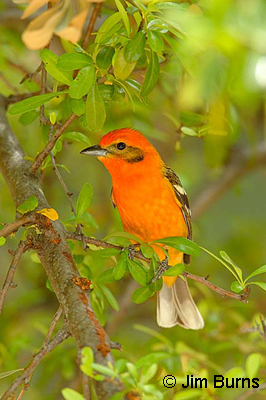
In 1996 Texas became the first state to designate a birding trail when it published a road map highlighting its many coastal birding areas. This initial project has evolved into The Texas Coastal Birding Trail covering 310 sites along a 2110 mile route. As of this writing 28 states, including Arizona, have birding trails, most of them with maps describing locations, best times to visit, and what species to expect. Some states have erected roadside markers to direct travelers to the sites.
The Southeastern Arizona Birding Trail, Arizona's first, is now available in roadmap format. It features 52 sites in four counties: Pinal, Graham, Pima, and Cochise, and is available from the Tucson Audubon Society, www.tucsonaudubon.org, and the Southeastern Arizona Bird Observatory, www.sabo.org. The back of the map has a thumbnail sketch of each site summarizing habitat, season, location, and access, along with symbols for the availability of nine amenities.
The sites range from the fully supported (wheelchair access and restaurant) such as the Arizona-Sonora Desert Museum in Tucson, to the primitive (no amenities and no fees) such as Upper Miller Canyon in the Coronado National Forest which was mentioned in my last column. The former merits inclusion because it is an oasis of native vegetation that attracts all of the typical Sonoran Desert species plus the occasional super rarity such as rufous-backed robin and yellow grosbeak. Upper Miller is home to many of the Sky Island specialties such as spotted owl, whiskered screech-owl, magnificent and blue-throated hummingbirds, painted redstart and red-faced warbler.
The term "Sky Island" refers to the several isolated mountain ranges that dot the deserts and grasslands south and east of Tucson whose elevation concentrates the summer monsoons and creates breeding habitat for many Mexican species that reach the northern limit of their range in Arizona, making our state the premier birding destination in the country. These species include the spectacular (elegant trogon), the fascinating (elf owl), and the rare (flame-colored tanager).
August, as summer rains and hummingbird numbers peak, is the perfect time to get your Southeastern Arizona Birding Trail site guide and head for the cool, damp Sky Islands. Whether you're a veteran lister or a curious beginner, whether you're a well conditioned hiker or really don't want to leave your air-conditioned vehicle, this is a "trail" with much to offer anyone with an interest in the Arizona outdoors, its scenic beauty, and its famous birdlife. The Sky Islands have more birds that you can't see anywhere else in the country than anywhere else in the country, and you don't even have to get on an airplane to go look for them.